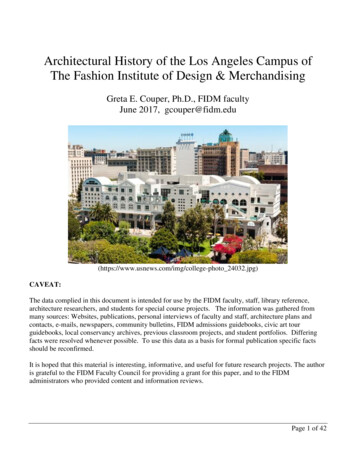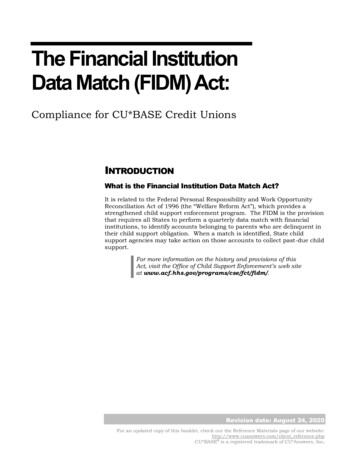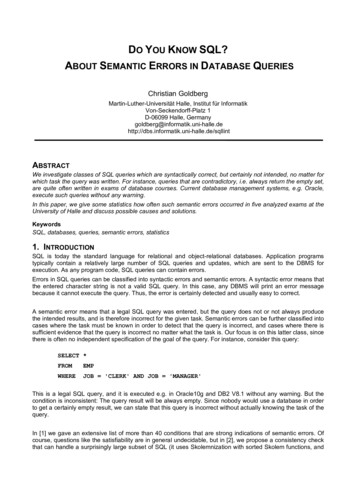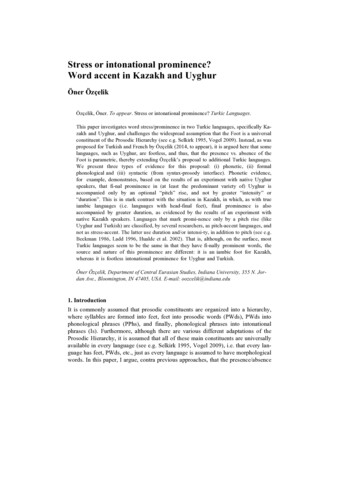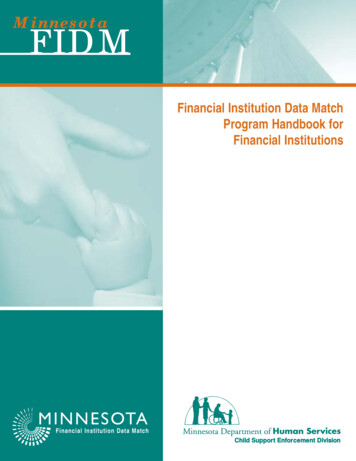
Transcription
MinnesotaFIDMFinancial Institution Data MatchProgram Handbook forFinancial InstitutionsMINNESOTAFinancial Institution Data MatchChild Support Enforcement Division
MINNESOTAF inancial I nstitution D ata M atchTable of ContentsExecutive Summary . . . . . . . . . . . . . . . . . . . . . . . . . . . . . . . . . . . . . . . . . . . . . . . . . . . . . . . . .1Historical Background & Program Summary . . . . . . . . . . . . . . . . . . . . . . . . . . . . . . . . . . . .2General Provisions. . . . . . . . . . . . . . . . . . . . . . . . . . . . . . . . . . . . . . . . . . . . . . . . . . . . . . . . .3Financial Institution Match Procedure . . . . . . . . . . . . . . . . . . . . . . . . . . . . . . . . . . . . . . . . . .6Use of Standardized Specifications and Reporting Methods . . . . . . . . . . . . . . . . . . . . . .6Multistate Financial Institution (MSFI) Program . . . . . . . . . . . . . . . . . . . . . . . . . . . . . . . .6In-state Financial Institution Program . . . . . . . . . . . . . . . . . . . . . . . . . . . . . . . . . . . . . . . .6FIDM Calendar for 2001 . . . . . . . . . . . . . . . . . . . . . . . . . . . . . . . . . . . . . . . . . . . . . . . . . . .8Changes in Reporting Methods, Service Providers, or Types of Media . . . . . . . . . . . .11Financial Institution Levy Procedure . . . . . . . . . . . . . . . . . . . . . . . . . . . . . . . . . . . . . . . . . .12Required Action by the Financial Institution . . . . . . . . . . . . . . . . . . . . . . . . . . . . . . . . . .12Notice to the Obligor . . . . . . . . . . . . . . . . . . . . . . . . . . . . . . . . . . . . . . . . . . . . . . . . . . . . .12Reimbursement of Financial Institutions . . . . . . . . . . . . . . . . . . . . . . . . . . . . . . . . . . . . . . .13Financial Institution Data Match Agreement . . . . . . . . . . . . . . . . . . . . . . . . . . . . . . . . . 14Invoice . . . . . . . . . . . . . . . . . . . . . . . . . . . . . . . . . . . . . . . . . . . . . . . . . . . . . . . . . . . . . . . . 15Information for 2002 Legislative Report . . . . . . . . . . . . . . . . . . . . . . . . . . . . . . . . . . . . . 16AppendicesAppendix A - Financial Data Match Specification HandbookAppendix B - Change FormAppendix C - Levy Process FormsAppendix D - Web Sites Related to FIDMAppendix E - How to Get More Information about Minnesota’s Child Support Programi
MINNESOTAF inancial I nstitution D ata M atchExecutive SummaryIntroductionMinnesota is implementing the Financial Institution Data Match program in 2001.Federal welfare reform enacted in 1996 changed public assistance to promote self-sufficiency. Toaid in the success of welfare reform, additional child support enforcement tools were mandated.One of these important tools is the Financial Institution Data Match (FIDM).FIDM is an enforcement tool which allows child support offices to match noncustodial parents whoowe delinquent child support with financial assets they own.Minnesota families will benefit from FIDM. In Minnesota there are more than 77,000 noncustodialparents who meet the statutory criteria for the Financial Institution Data Match (FIDM) program.These noncustodial parents owe 900 million in uncollected support that could benefit as many as107,000 children. Our goal is to improve the lives of these children by collecting this money andpaying it to families.PurposeThe purpose of FIDM is to identify assets belonging to noncustodial parents who are delinquent intheir child support obligations. Once identified, if all criteria under Minnesota Statutes, sections552.04 and 552.06 are met, the account assets may be seized and applied to the child support arrears.Financial Institution Steps for FIDM Implementation1.Decide if data match will be done by in-house data processing staff or a service provider. Manyfinancial institutions contract with reporting agents (also known as service agents, serviceproviders, or transmitters) for Internal Revenue Service Form 1099 reporting. Since thespecifications for FIDM are similar to the Form 1099 format, these reporting agents/transmittersmay also be used to report data match information.2.Decide which data match methodology to use (all accounts or matched accounts). The datamatches are done by either of the two methods using data specifications approved by the U. S.Department of Management and Budget. Under Method One (all accounts method) thefinancial institution submits a file containing all open accounts. This file is matched againstrecords of delinquent obligors. Under Method Two the financial institution receives a filecontaining records of delinquent obligors, matches the files against all open accounts, andsubmits a file of matched records to the:Minnesota Financial Institution Data Match ProgramP. O. Box 64915St. Paul, MN 55164-09153.Select the media for sending and receiving data to and from the FIDM Data Match Program.See page 11.1
MINNESOTAF inancial I nstitution D ata M atch4.Identify a contact person(s) who will be responsible for the FIDM program within the financialinstitution. Child Support Enforcement Division (CSED) needs to know who will be responsiblefor the technical aspects of the data match process, the legal aspects of the levy on assets, andoverall coordination of the FIDM program. Share a copy of this program guide for financialinstitutions with each contact person. Information about technical aspects begins on page 6 ,and information about the levy process is on page 12. The technical contact person will alsoneed a copy of the Office of Child Support Enforcement (OSCE) Financial Data Match SpecificationHandbook available from OCSE’s web site at: x.htm. Click on “Data Specs” and an Adobe Acrobat version of the Handbookwill be displayed. The Data Specifications are also included as an Appendix to this document.5.Complete the FIDM Agreement, including signature(s) of officers or executives of the financialinstitution, and return the signed form as directed.6.Start match process according to your financial institution’s selected Match Method anddesignated week as selected in the FIDM Agreement.Historical Background & Program SummaryFederal welfare reform was designed to ensure that noncustodial parents take a fair share of theresponsibility for the financial support of their children. Federal law, Public Law 104-193, thePersonal Responsibility and Work Opportunity Reconciliation Act of 1996 (PRWORA), includesnumerous enforcement tools intended to increase child support collections.Federal law, 42 United States Code section 666 (a)(17)(A), requires each state, in cooperation withthe financial institutions operating in that state, to develop and operate a data match program. Eachfinancial institution doing business in the state will provide quarterly the name, record address,social security number, and other identifying information for each noncustodial parent whomaintains an account at such institution and who owes past-due child support. The financialinstitution is required to encumber or surrender the assets of the delinquent obligor held by theinstitution in response to a notice of lien or levy issued by the child support agency.Federal law, 42 United States Code section 666 (a)(17)(A)(i), modified PRWORA permits financialinstitutions operating in two or more states to elect to conduct the match through OCSE’s FederalParent Locator Service (FPLS). OCSE will conduct the data-matching program for multi-statefinancial institutions based on delinquent parent files submitted by state child support enforcementagencies. OCSE will turn the matches over to the appropriate state agency.The 2000 Minnesota Legislature passed the law that defines Minnesota’s requirements for FIDM.Under Minnesota Statutes, section 13B.06, the Minnesota Department of Human Services ChildSupport Enforcement Division (CSED), in coordination with representatives of the financial industryin Minnesota, is required to operate a quarterly financial institution data match program usingautomated data exchanges on the name, address, and social security number of each account holderto the maximum extent feasible. On a quarterly basis, CSED matches a list of child support obligorswho are not in compliance with an order for support against the records of account holders atfinancial institutions to locate assets. CSED initiated a contract with Policy Studies Inc. (PSI) tomanage the day-to-day operations of the FIDM program, the quarterly data exchange between thein-state financial institutions’ files and CSED’s files, and provide customer service and outreachservices to financial institutions regarding the FIDM program.2
MINNESOTAF inancial I nstitution D ata M atchWhen a matched record is received, CSED may issue a notice of levy to the financial institution ifthe statutory criteria of Minnesota Statutes, section 552.06, subd.1 are met.Upon receipt of the levy, the financial institution places a hold on all the obligor’s accounts, up tothe amount of the child support levy, for 45 days. CSED notifies the obligor of the levy within threebusiness days, at which time the obligor may file a contest motion of the levy. This contest motionmust be filed within 30 days. In the event of a levy appeal, CSED will issue a notice to the financialinstitution to continue to hold the funds until the contest is resolved. The court must schedule thehearing to be heard within 10 days of the obligor’s request. CSED will issue a notice to the financialinstitution regarding the hearing results. The financial institution will either release the accounts orremit the funds to CSED after 45 days.General ProvisionsAuthority!!!42 United States Code section 666 (a)(17)Minnesota Statutes, section 13B.06Minnesota Statutes, sections 552.04 and 552.063
MINNESOTAF inancial I nstitution D ata M atchDefinitions Under Minnesota Statutes, section 13B.06 and Minnesota Statutes,section 518.54“Account” means a demand deposit account, checking or negotiable withdrawal order account,savings account, time deposit account, or money market mutual fund.“Account information” means the type of account, the account number, whether the account issingly or jointly owned and in the case of jointly owned accounts the name and address of thenonobligor account owner is required if available.“Financial institution” means any of the following that do business within the state:!!!!!!federal or state commercial banks, including savings and loan associations and cooperativebanksfederal and state chartered credit unionsbenefit associationslife insurance companiessafe deposit companiesmoney market mutual funds“Public Authority” means the public authority responsible for child support enforcement.“Obligor” means an individual who is in arrears in court-ordered child support or maintenancepayments, or both, in an amount equal to or greater than five times the obligor’s total monthlysupport and maintenance payments.“Support” means all payments or other obligations due and owing to the obligee pursuant to asupport order, and may include but is not limited to, child support, medical insurance or otherhealth care premiums, child care obligations, support alimony payments, and other obligations.“Support order” means an order for the payment of support issued by a Minnesota court or by acourt or administrative agency of another state.Protection for Financial InstitutionsFederal law, 42 United States Code section 666 (a)(17)(C), establishes that a financial institution shallnot be liable under any federal or state law to any person for any disclosure of information to theState IV-D Agency for providing the required information covered in section 666 (a)(17)(A)(i).Similarly, financial institutions shall not be liable under federal or state law for encumbering orsurrendering any assets they hold in response to a notice of lien or levy issued by the IV-D agency.In addition, financial institutions will not be held liable for any other action taken in good faith tocomply with the requirements of section 666 (a)(17)(A).Fees!Data match process. The State child support agency may pay a reasonable fee to financialinstitutions conducting the financial institution data match, not to exceed the actual costsincurred by the institution. Please refer to page 13, Reimbursement of Financial Institutions for anexplanation of the fee.!Levying account. The financial institution may assess a fee not to exceed 15 for each leviedaccount. If the financial institution assesses a fee, the institution must deduct it from theaccount before surrendering the levied funds to CSED.4
MINNESOTAF inancial I nstitution D ata M atchPenaltiesMinnesota Statute, section 13B.06 address penalties for noncompliance as follows:13B.06 Subd. 8. Failure to respond to request for information. The public authority shall send bycertified mail a written notice of noncompliance to a financial institution that fails to respond to afirst written request for information under this section. The notice of noncompliance must explainthe requirements of this section and advise the financial institution of the penalty for noncompliance.A financial institution that receives a second notice of noncompliance is subject to a civil penalty of 1,000 for its failure to comply. A financial institution that continues to fail to comply with thissection is subject to a civil penalty of 5,000 for the third and each subsequent failure to comply.These penalties may be imposed and collected by the public authority.A financial institution that has been served with a notice of noncompliance and incurs a second orsubsequent notice of noncompliance has the right to a contested case hearing under chapter 14. Afinancial institution has 20 days from the date of the service of the notice of noncompliance to file arequest for a contested case hearing with the Minnesota Department of Human Services. The orderof the administrative law judge constitutes the final decision in the case.Access to DataMinnesota Statute, section 13B.06 addresses access to data as follows:13B.06. Subd. 6. Access to data. (a) With regard to account information on all accountholders provided by a financial institution under subdivision 4, clause (1), the commissionerof human services shall retain the reported information only until the account information iscompared against the public authority's obligor database. Notwithstanding section 138.17,all account information that does not pertain to an obligor listed in the public authority'sdatabase must be immediately discarded, and no retention or publication may be made ofthat data by the public authority. All account information that does pertain to an obligorlisted in the public authority's database must be incorporated into the public authority'sdatabase. Access to that data is governed by chapter 13. Notwithstanding section 16D.06,data collected pursuant to this chapter is available for the collection of child support debtonly and is not available for other debt collection activities undertaken by the state underchapter 16D.(b) With regard to data on obligors provided by the public authority to a financial institutionunder subdivision 4, clause (2), the financial institution shall retain the reported informationonly until the financial institution's database is compared against the public authority'sdatabase. Data that does not pertain to an account holder at the financial institution must beimmediately discarded, and no retention or publication may be made of that data by thefinancial institution.The data supplied by financial institutions using Method 1: All Accounts will only be retained until theaccount information is matched against CSED’s database of delinquent obligors. All unmatchedaccount information will be deleted and/or destroyed after the match process is complete.Unmatched account information will not be retained or published or in any way made available tothe public. CSED will incorporate only the matched information into its database and use it to collectchild support debt. Access to this matched information is governed by the Minnesota Data PracticesAct and specifically, Minnesota Statues, section § 13.46.Further, with regard to the file of delinquent obligors that is provided to financial institutionsselecting Method 2: Matched Accounts, the financial institution shall retain the reported informationonly until the financial institution's database is compared against the file of delinquent obligors.Data that does not pertain to an account holder at the financial institution must be immediatelydiscarded, and no retention or publication may be made of that data by the financial institution. Theoriginal media file that is sent to the financial institution to conduct the match must be returned toPSI when the matched accounts file is submitted for the quarterly data match processing.5
MINNESOTAF inancial I nstitution D ata M atchFinancial Institution Data Match ProcedureUse of Standardized Specifications and Reporting MethodsData matches are done by either of the following two methods using data specifications approvedby the U. S. Department of Management and Budget (OMB Control Number 0970-0196) also knownas Financial Data Match Specification Handbook. A copy of the file layouts are included as part of thisdocument as Appendix A. The Financial Data Match Specification Handbook can also be downloadedfrom the OCSE web site ndex.htmClick on “Data Specs” and an Adobe Acrobat version of the Handbook will be displayed.Under Method One (all accounts method) the financial institution submits a file containing all openaccounts. The file is matched against records of delinquent obligors.Under Method Two (matched accounts method) the financial institution receives a file containingrecords of delinquent obligors, matches the files against all open accounts, and submits a file ofmatched records.Multistate Financial Institution(MSFI) ProgramMultistate financial institutions must conduct data matches against their account records with eachstate in which they do business. MSFIs have the option to conduct their matches through OCSE orwith individual states in which they do business. OCSE has distributed an Election Form thatallows MSFIs to select the means of data transmission, reporting periods, and service providers ifappropriate. The Election Form also allows MSFIs to opt out of the OCSE process in favor ofparticipating with the individual states. For information on the Election Form and data match timelines, refer to OCSE’s FIDM web /index.htmIn-State Financial Institution ProgramCSED is required to enter into agreements with financial institutions doing business in Minnesota toconduct a quarterly data match. This includes MSFIs who opt out of the OCSE process in favor ofparticipating in the Minnesota FIDM process. A copy of the Agreement form is included with thisdocument.6
MINNESOTAF inancial I nstitution D ata M atchMethod OneMethod TwoFinancial institutionssubmit files listing allaccount holders to StateFIDM vendor, PSI.CSED sends file ofdelinquent obligors tostate FIDM vendor, PSI.PSI matches delinquentobligor records againstaccount records sent bythe financial solutions.PSI sends file ofdelinquent obligors tofinancial institutions ontheir requested mediatype.PSI sends matchedaccount records toCSED daily.Financial institutionsmatch the file fromCSED against theiraccount holder files.CSED verifies that thechild support arrearsare still owed.Financial institutionssend the files of allmatched accounts (i.e.account holders whoowe child supportarrears) to PSI.CSED issues levies onaccounts to financialinstitutions and toaccount holders owingchild support.PSI sends matchedaccount records toCSED daily.Financial institutionsfreeze funds inaccounts up to theamount of the childsupport arrears andforward to CSED.CSED verifies that thechild support arrearsare still owed.CSED issues levies onaccounts to financialinstitutions and toaccount holders owingchild support.Shaded items indicate after data match is completed7Financial institutionsfreeze funds inaccounts up to theamount of the childsupport arrears andforward to CSED.
MINNESOTAF inancial I nstitution D ata M atchData Match CalendarThe Data Match calendar provides additional explanations about submitting files in either MethodOne or Method Two and the dates for submitting data files for quarterly matching in calendar years2001, 2002 and 2003.Method One - All AccountsFor Financial Institutions selecting Method One, institutions need to select a week of the quarter forsubmitting files to the Minnesota FIDM program for processing. The dates listed are the dates whenthe file needs to be received by the Minnesota FIDM program.Quarterly Data exchange schedule for remainder of calendar year 2001Week4th Quarter ober 1-5October 8-12October 15-19October 22-26October 29-November 2November 5 - November 9November 12-16November 19-23November 26-30December 3-7December 10-14December 17-21December 24-28Method Two - Matched AccountsChild SupportFile will be sentto FinancialInstitutions theweek of:MatchedAccounts filesent to FIDM nolater than theweek of:Child SupportFile will be sentto FinancialInstitutions theweek of:MatchedAccounts filesent to FIDM nolater than theweek of:4th ber17-211200For Financial Institutions selecting Method Two, institutions can select the first half of the quarter orthe second half of the quarter to conduct their quarterly matching. The dates listed are when thechild support file will be sent to your institution and the dates when the matched accounts fileshould be received by the Minnesota FIDM program for processing.8
MINNESOTAF inancial I nstitution D ata M atchMethod One - All AccountsFor Financial Institutions selecting Method One, institutions need to select a week of the quarter forsubmitting files to the Minnesota FIDM program for processing. The dates listed are the dates whenthe file needs to be received by the Minnesota FIDM program.Quarterly Data exchange schedule for the calendar year of 2002Week1st Quarter 20022nd Quarter 20023rd Quarter 20024th Quarter . 31-Jan. 4January 7-11January 14-18January 21-25January 28- Feb. 1February 4-8February 11-15February 18-22Feb. 25-March 1March 4-8March 11-15March 18-22March 25-29March 31-April 5April 8-12April 15-19April 22-26April 29-May 3May 6-10May 13-17May 20-24May 27-31June 3-7June 10-14June 17-21June 24-28July 1-5July 8-12July 15-19July 22-26July 29-August 2August 5-9August 12-16August 19-23August 26-30September 2-6September 9-13September 16-20September 23-27Sept. 30-Oct. 4October 7-11October 14-18October 21-25Oct. 28-Nov. 1November 4-8November 11-15November 18-22November 25-29December 2-6December 9-13December 16-20December 23-27Method Two - Matched AccountsFor Financial Institutions selecting Method Two, institutions can select the first half of the quarter orthe second half of the quarter to conduct their quarterly matching. The dates listed are when thechild support file will be sent to your institution and the dates when the matched accounts fileshould be received by the Minnesota FIDM program for processing.MatchedAccounts filesent to FIDM nolater than theweek of:Child SupportFile will be sentto FinancialInstitutions theweek of:MatchedAccounts filesent to FIDM nolater than theweek of:1st 25-292nd QuarterApril15-19May20-24May20-24June24-283rd 274th ber23-272002Child SupportFile will be sentto FinancialInstitutions theweek of:9
MINNESOTAF inancial I nstitution D ata M atchMethod One - All AccountsFor Financial Institutions selecting Method One, institutions need to select a week of the quarter forsubmitting files to the Minnesota FIDM program for processing. The dates listed are the dates whenthe file needs to be received by the Minnesota FIDM program.Quarterly Data exchange schedule for the calendar year of 2003Week1st Quarter 20032nd Quarter 20033rd Quarter 20034th Quarter . 30-Jan. 3January 6-10January 13-17January 20-24January 27-31February 3-7February 10-14February 17-21February 24-28March 3-7March 10-14March 17-21March 24-28March 31-April 4April 7-11April 14-18April 21-25April 28-May 2May 5-9May 12-16May 19-23May 26-30June 2-6June 9-13June 16-20June 23-27June 30-July 4July 7-11July 14-18July 21-25July 28-August 1August 4-8August 11-15August 18-22August 25-29September 1-5September 8-12September 15-19September 22-26Sept. 29-Oct. 3October 6-10October 13-17October 20-24October 27-31November 3-7November 10-14November 17-21November 24-28December 1-5December 8-12December 15-19December 22-26Method Two - Matched AccountsFor Financial Institutions selecting Method Two, institutions can select the first half of the quarter orthe second half of the quarter to conduct their quarterly matching. The dates listed are when the childsupport file will be sent to your institution and the dates when the matched accounts file should bereceived by the Minnesota FIDM program for processing.MatchedAccounts filesent to FIDM nolater than theweek of:Child SupportFile will be sentto FinancialInstitutions theweek of:MatchedAccounts filesent to FIDM nolater than theweek of:1st 24-282nd QuarterApril14-18May19-23May19-23June23-273rd 264th ber22-262003Child SupportFile will be sentto FinancialInstitutions theweek of:10
MINNESOTAF inancial I nstitution D ata M atchMedia TypesFinancial institutions may use any of the following media to submit their data files:!!!!!!!1.44MB 3.5” diskettes (ASCII)CD ROM (ASCII)3480/3490 Cartridge (EBCDIC or ASCII)9-track Round Reel (EBCDIC or ASCII)High density disks such as ZipDisks or SuperDisks4 mm DDS4 tapesPaper listsMinnesota FIDM Program ContactsFinancial institutions may contact the FIDM operations vendor, Policy Studies Inc., for moreinformation about submitting their files and media types:Minnesota Financial InstitutionData Match ProgramPO Box 64915St. Paul, MN 55164-0915Phone: 651-293-1499Toll-free: 1-866-879-0200Fax: 651-222-4599Contacts:Dawn GelleProgram ManagerPhone: (651) 293-1499 ext. 100Toll-free: 1-(866) 879-0200 ext. 100Email: dgelle@policy-studies.comJim MoenchOutreach CoordinatorPhone: (651) 293-1499 ext. 200Toll-free: 1-(866) 879-0200 ext. 200Email: jmoench@policy-studies.comChanges in Reporting Methods, Service Providers or Types of MediaIn-state financial institutions and MSFIs who opt out of the OCSE process may record changes inreporting methods, service providers, or types of media by completing CSED’s Change Formincluded in this document as Appendix B. Only one method change per year will be allowed.11
MINNESOTAF inancial I nstitution D ata M atchFinancial Institution Levy ProcedureAuthority!!Minnesota Statutes, section 13B.06Minnesota Statutes, sections 552.04 and 552.06Levy of Assets in Financial Institutions For Collection of SupportCSED is authorized to issue a Notice of Levy for accounts maintained by an obligor in financialinstitutions to collect past-due support in cases where a child support arrearage equals or exceeds fivetimes the monthly support obligation, the obligor has failed to make full payments required by apreviously executed payment agreement, and where the arrearages have already been submitted for offsetagainst federal or state tax refunds.Property Subject to the LevyAny accounts maintained by an obligor in a financial institution are subject to the levy.Levying on Joint AccountsJoint accounts are subject to levy.Required Action by the Financial InstitutionUpon receipt of the Notice of Levy, the financial institution must:1.Immediately freeze funds in all accounts in which the obligor has an interest, up to the amount of thepast-due support indicated in the Notice of Levy Action (Appendix C, page 36); and2.Hold the encumbered funds for 45 calendar days from the date of receipt of the levy. The institutionmust suspend any and all activity with respect to, and payments from, any and all accounts of theobligor up to the amount levied. The suspension (holding period) must continue for 45 days.Additional deposits may be made into the account(s) during the 45 day holding period. These fundsare excluded from the levy action and may be withdrawn even if the account balance at date of thereceipt of the levy was less than the amount requested in the levy.3.Surrender the encumbered funds to CSED after 45 days unless otherwise notified by CSED.CSED will pay the financial institution 15 for each levied account the month following issuance of theNotice of Levy Action. CSED will send one check to each financial institution regardless of how many levyrequests were made to that financial institution in the previous month.Notice to the ObligorCSED will notify the obligor that a levy has occurred within three business days after the Notice of LevyAction is sent to the financial institution. This notice will include information regarding how to claimexemptions, contest the levy, and prevent future levies.The obligor must file an exemption claim within 20 days or file a contest motion in court within 30 days.If contested, a hearing must be held within 10 days of obligor’s request.CSED will immediately notify the financial institution if a contest motion is filed. The financial institutionwill continue to hold the funds until notified of the results of the hearing (even if after 45 days).Upon issuance of an order, CSED will immediately notify the financial institu
FIDM is an enforcement tool which allows child support offices to match noncustodial parents who owe delinquent child support with financial assets they own. Minnesota families will benefit from FIDM. In Minnesota there are more than 77,000 noncustodial parents who meet the statutory criteria for the Financial Institution Data Match (FIDM) program.
